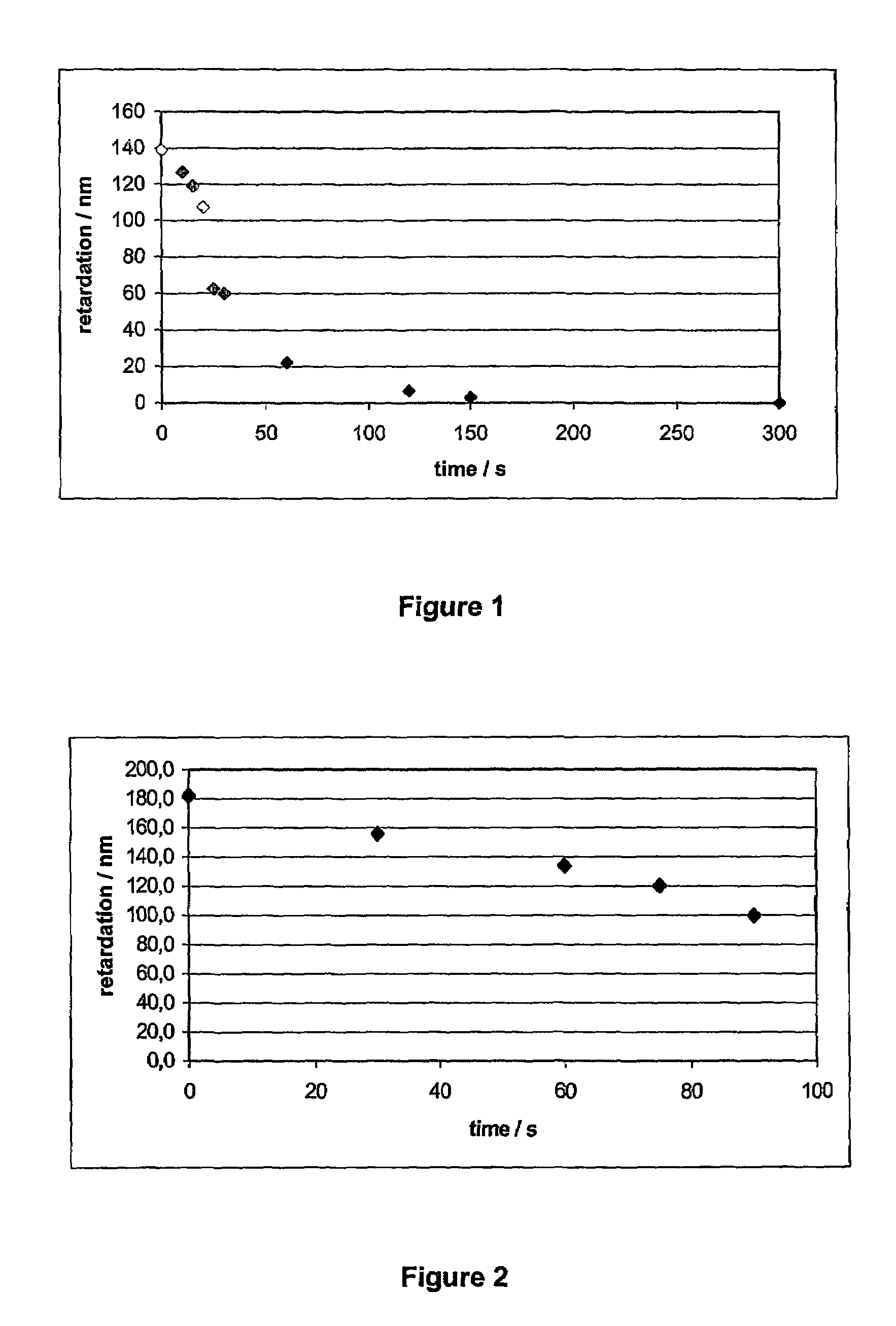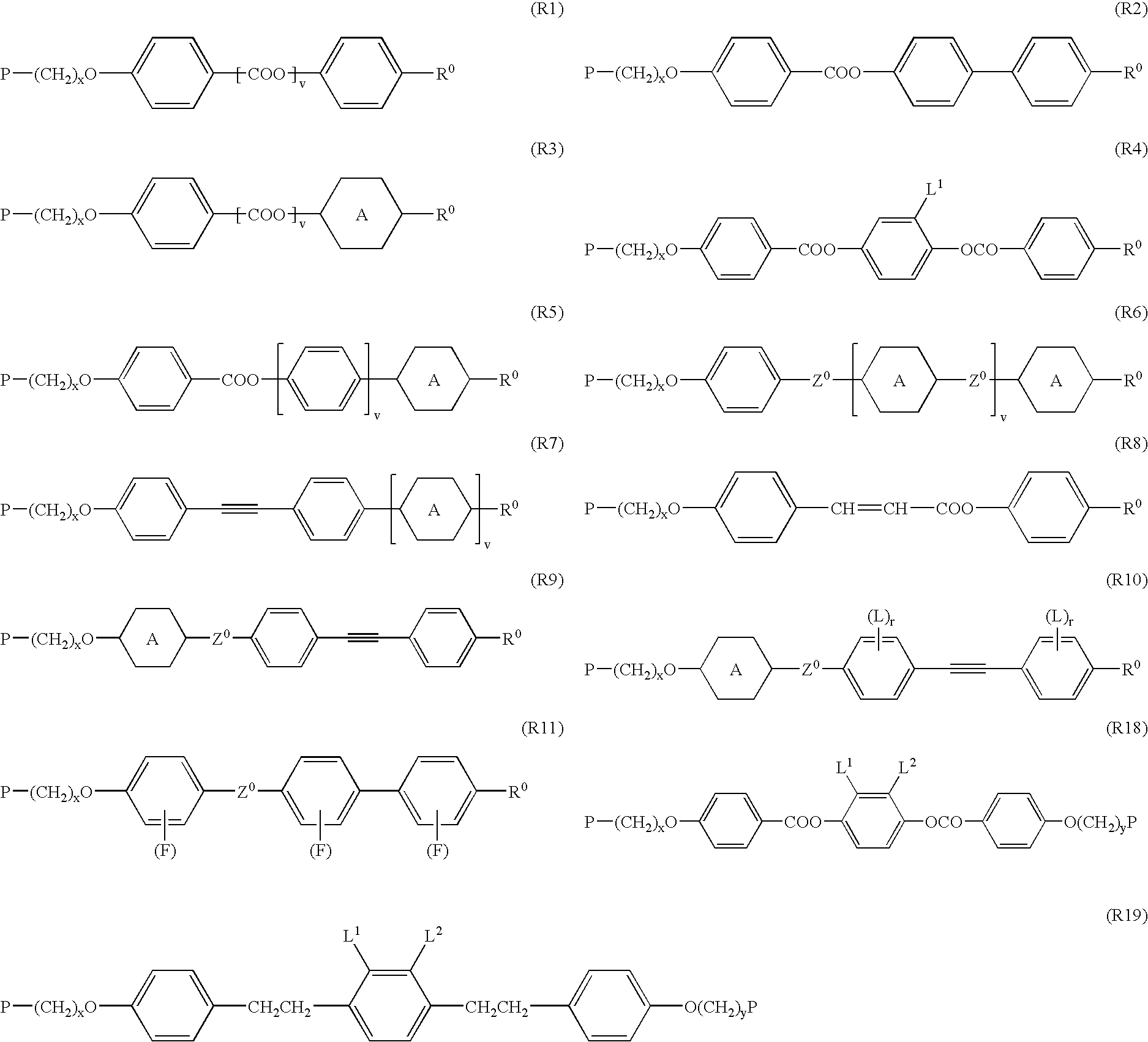Polymerised liquid crystal film with retardation or orientation pattern
a technology of retardation or orientation pattern, applied in the field of polymerised liquid crystal film, can solve problems such as non-perfect conversion, and achieve the effect of pronounced mechanical stability and flexibility
- Summary
- Abstract
- Description
- Claims
- Application Information
AI Technical Summary
Benefits of technology
Problems solved by technology
Method used
Image
Examples
example 1
[0141]The polymerisable LC mixture M1 was formulated, wherein the polymerisable component consists exclusively of isomerisable RMs (i.e. the total amount of isomerisable compounds in the polymerisable component is 100 mol %)
[0142]
M1:(1)9.0%(2)23.0%(3)14.4%(4)18.0%(5)17.0%(6)17.0%Irgacure 6511.0%Fluoran FC1710.6%
[0143]The compounds (1) to (6) are known in prior art. Irgacure 651 is a commercially available photoinitiator (from Ciba AG, Basel, Switzerland). Fluorad FC 171 is a commercially available non-ionic fluorocarbon surfactant (from 3M).
[0144]The mixture was dissolved to create a 50 wt % solution in xylene. This solution was filtered (0.2 μm PTFE membrane) and spin coated onto glass / rubbed polyimide slides (low pretilt polyimide JSR ALI 054 from Japan Synthetic Rubber). The films were exposed to 20 mWcm−2 365 nm radiation in air for varying lengths of time. Subsequently, the films were photopolymerised using 20 mWcm−2 UV-A radiation, for 60 seconds in an N2-atmosphere. The retar...
example 2
[0148]The polymerisable LC mixture M2 was formulated, containing 32 wt. % of non-isomerisable reactive mesogen (7).
[0149]
M2:(3)14.4%(4)18.0%(5)17.0%(6)17.0%(7)32.0%(non-isomerisable)Irgacure 6511.0%Fluorad FC1710.6%
[0150]In M2, the total amount of isomerisable compounds (3) to (6) in the polymerisable component (consisting of compounds (3) to (7)) is 72.8 mol %, and the amount of non-isomerisable compound (7) in the polymerisable component is 27.2 mol %.
[0151]Films of this mixture were prepared and analysed as detailed in Example 1. The retardation at normal incidence is plotted as a function of irradiation time in FIG. 2.
[0152]From the retardation data the orientation of the LC-molecules in the films was also determined. It was found that after exposure to 75 seconds of 20 mWcm−2 365 nm light the films produced changed from being planar to being splayed. Therefore, films of this mixture preserve their planar alignment better than those in Example 1. The film thickness was measured ...
example 3
[0155]A) A first polymerised planar LC layer, prepared from mixture M1 as detailed in Example 1, was used as substrate and subsequently coated with a second layer of the same LC mixture M1 that was then polymerised. The second layer was found to be planar aligned. Thus, a stack comprising two planar polymerised LC films was produced.
[0156]B) A first and second polymerised LC layer were prepared as described in A), but the second layer was irradiated with a sufficient dose of UV light of 365 nm prior to polymerisation so that it showed splayed alignment. Thus, a stack comprising a planar and a splayed polymerised LC film was produced.
[0157]C) A first splayed LC layer was prepared from mixture M1 as described in Example 1 and used as an alignment layer. A second layer of the same LC mixture M1 was coated onto the side of the first splayed film showing maximum tilt angle, i.e. having approximately homeotropic orientation. The mixture in the second layer was irradiated with UV light of ...
PUM
| Property | Measurement | Unit |
|---|---|---|
| mol % | aaaaa | aaaaa |
| mol % | aaaaa | aaaaa |
| mol % | aaaaa | aaaaa |
Abstract
Description
Claims
Application Information
 Login to View More
Login to View More - R&D
- Intellectual Property
- Life Sciences
- Materials
- Tech Scout
- Unparalleled Data Quality
- Higher Quality Content
- 60% Fewer Hallucinations
Browse by: Latest US Patents, China's latest patents, Technical Efficacy Thesaurus, Application Domain, Technology Topic, Popular Technical Reports.
© 2025 PatSnap. All rights reserved.Legal|Privacy policy|Modern Slavery Act Transparency Statement|Sitemap|About US| Contact US: help@patsnap.com



